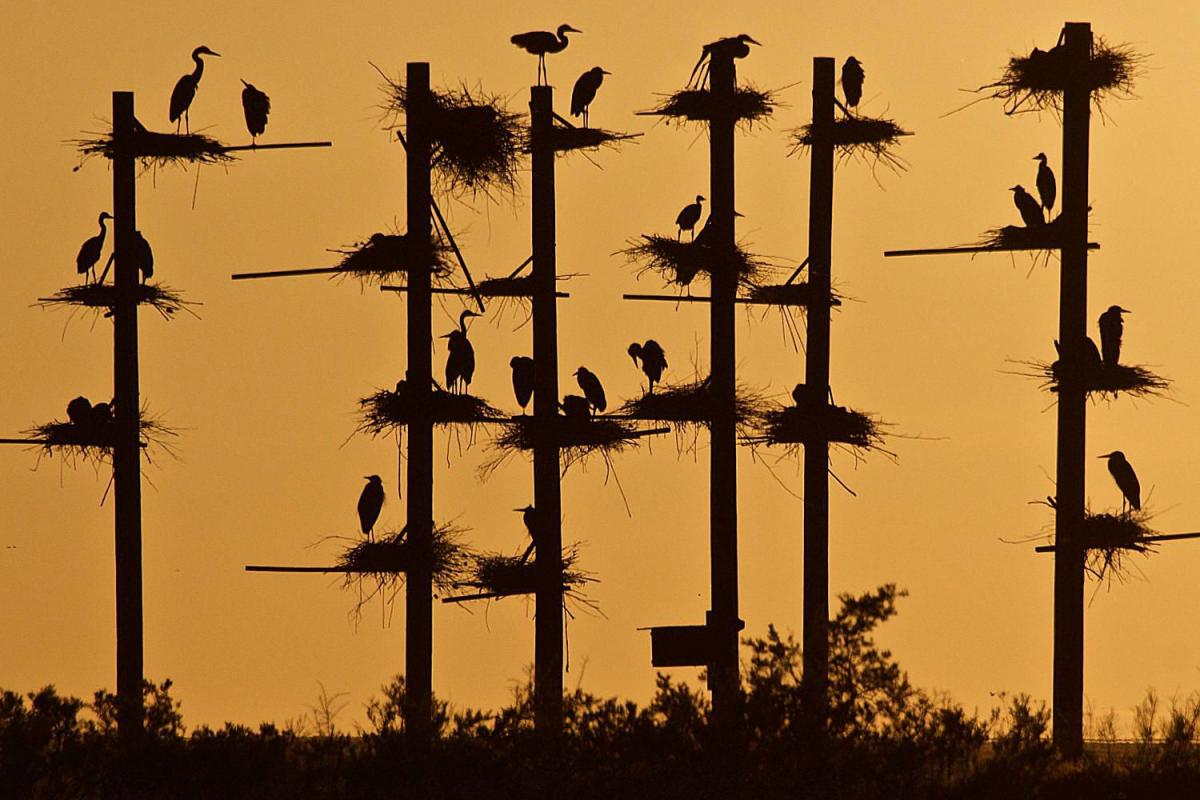For those who are up at 5-6 AM and like to walk the nature trail in St. Michaels, don’t be surprised if you hear very loud, angry squawks coming from the tips of the loblolly pines across the covered bridge.
Great Blue Herons have a rookery (also called a heronry) there. In the early morning, you can often see the herons’ silhouettes, shimmering in the dawn light, at the very top of the loblolly pines. While heronries can include up to 500 nests, I suspect this rookery features fewer than a dozen.
And, let’s face it, the sounds herons make are as ugly as herons are mesmerizing. Their voices are most strident in the morning, and I wonder if they are merely feeding greedy chicks, as great Blue Herons can hunt at night and during the day. After the squawking abates, a few herons fly away.
According to ornithologists, Great Blue Herons are somewhat indifferent parents, and their nests may be a reflection. The nests lack curb appeal; built from twigs and lined inside with moss, leaves, grass, and other soft materials.
Some Great Blue Herons overwinter on the Eastern Shore, but many return from South America in mid-March and April. They typically begin laying eggs in April, but this year it could have been delayed by the cold spring.
Migrating males arrive first, choose an existing nest from last year’s rookery, and work their charms. The females arrive and select their mate for the year. They stay together for the childcare period but find different mates the following year.
After selecting the nest, it is time to upgrade. The male supplies the material and the female, the decorating skills. Their nests can get pretty large, from 20 to 45 inches. She lays between 2-5 greenish-blue eggs. The parents share the incubating duties and within a month, voila chicks!
According to the Chesapeake Bay Program website, Great Blue Herons can be a little cruel (or pragmatic, depending on your perspective). While they typically lay up to five eggs; they will only feed one or two of the hatchlings and allow the others to starve to death. Chicks hatch over a couple of days which gives the oldest a decided advantage in the fight for survival.
Great Blue Herons are not known as being particularly attentive guardians, and have been observed nesting near eagles, buzzards, and other predatory birds.
The hatchlings stay in the nest from 1 ½ to 2 ½ months. So, probably by now, everyone’s nerves are frayed. And like human babies, young adult chicks continue to return to the nest for meals for several weeks after leaving.
Our brackish waters are a heron’s dream, and they will dine on the variety that is available to them including fish, amphibians, reptiles, small mammals, insects, and other birds. We have a ringside seat to their hunting skills on the Eastern Shore, it is unusual to see a waterway at low tide without an elegant Great Blue Heron. They silently stalk their prey in the shallow, muddy water, motionless for hours. In a quick flash, they will plunge their bills into the murky water. They grab smaller prey using their beaks like scissors. They use their sharp, long beaks as knives to impale larger quarry. But they need to be careful, Great Blue Herons can choke on larger prey.
Back in the rookery, their young get regurgitated food from both parents.
I do wonder, what is all the commotion in the heronry? Are we dealing with teenagers demanding their meals? Are they arguing about whose turn it is to get the food…or is this their way of communicating? It certainly sounds like an unpleasant conversation. Last week, the grumbling was particularly fierce and at the end, I saw four white Ibis fly away.
It has quieted down now, maybe the young ones have left for good.
But if you missed them, don’t worry. Herons come back to the same heronry every year, but not to the same nest. And when they are 1 ½ years old, these new fledglings will return to their hometown rookery, to take their place as parents.
It is a sight worth seeing, but maybe not hearing.
Angela Rieck, a Caroline County native, received her PhD in Mathematical Psychology from the University of Maryland and worked as a scientist at Bell Labs, and other high-tech companies in New Jersey before retiring as a corporate executive. Angela and her dogs divide their time between St Michaels and Key West Florida. Her daughter lives and works in New York City.



Maggie Andersen says
What a lovely essay Angela!
Angela Rieck says
Thank you!
Hugh Panero says
Thank you so much for this article. We have a rookery at the end of our street on Maxmore Creek. A favorite activity is having friends over and watching their expression upon hearing the Jurassic Park like soundtrack from the treetops followed by “What the hell is that?” We love the Blue Herons especially their ability to one moment appear as a cartoonish stick figure, wadding in the water and a second later flying away like a regal Pterodactyl dinosaur.
Angela Rieck says
I love your imagery.